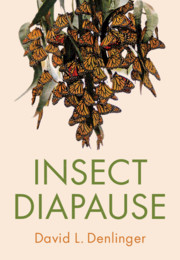Book contents
- Insect Diapause
- Insect Diapause
- Copyright page
- Dedication
- Contents
- Preface
- 1 Confronting the Challenges of a Seasonal Environment
- 2 Which Seasons Are Being Avoided?
- 3 Variation in the Diapause Response
- 4 The Cost of Diapause and Some Diapause Alternatives
- 5 Interpreting Seasonal Cues to Program Diapause Entry
- 6 Preparing for Diapause
- 7 The Diapause State
- 8 Ending Diapause and Reinitiating Development
- 9 Molecular Signaling Pathways that Regulate Diapause
- 10 Genetic Control of Diapause
- 11 Evolution of Diapause
- 12 Wider Implications
- References
- Species Index
- Subject Index
- Plate Section (PDF Only)
1 - Confronting the Challenges of a Seasonal Environment
Published online by Cambridge University Press: 13 January 2022
- Insect Diapause
- Insect Diapause
- Copyright page
- Dedication
- Contents
- Preface
- 1 Confronting the Challenges of a Seasonal Environment
- 2 Which Seasons Are Being Avoided?
- 3 Variation in the Diapause Response
- 4 The Cost of Diapause and Some Diapause Alternatives
- 5 Interpreting Seasonal Cues to Program Diapause Entry
- 6 Preparing for Diapause
- 7 The Diapause State
- 8 Ending Diapause and Reinitiating Development
- 9 Molecular Signaling Pathways that Regulate Diapause
- 10 Genetic Control of Diapause
- 11 Evolution of Diapause
- 12 Wider Implications
- References
- Species Index
- Subject Index
- Plate Section (PDF Only)
Summary
Our highly seasonal world imposes environmental challenges for insects. To survive these inimical periods they rely on a diapause (dormancy) mechanism to bridge unfavorable seasons. The origin of the term “diapause” is discussed, as well as its relationship to related forms of dormancy in other animals. Diapause is distinct from quiescence in that it is not an immediate response to an adverse environment but is programmed at an earlier developmental stage, an attribute that enables the insect to take steps in preparation for entering the arrested state. Diapause can occur at any point in the life cycle (embryo, larva, pupa, adult), but when it occurs it is species-specific. The chapter summarizes who does it and in what stage, as well as addressing the occurrence of diapause in social insects. The pervasive impact of diapause on the insect life cycle begins prior to diapause and continues well beyond its termination.
Keywords
- Type
- Chapter
- Information
- Insect Diapause , pp. 1 - 18Publisher: Cambridge University PressPrint publication year: 2022
- 1
- Cited by

